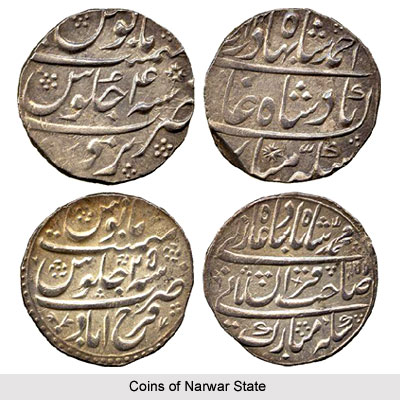 The Princely State of Narwar was one of the princely states of India during the rule of the British Empire in India. During the early 19th century, the region was appointed as one of the princely states of India under the indirect rule of the British administration. The region was scattered over a total area of 16 sq km and it was a part of the erstwhile Malwa Agency. The region comprised of a total population of 1,817 in the year 1911. The Princely State of Narwar was incorporated as a part of the Central India Agency. The state was a small enclave located in the northwest part of the Karera section of Gwalior. It lied towards the west the towns of Orchha, Jhansi and Datia.
The Princely State of Narwar was one of the princely states of India during the rule of the British Empire in India. During the early 19th century, the region was appointed as one of the princely states of India under the indirect rule of the British administration. The region was scattered over a total area of 16 sq km and it was a part of the erstwhile Malwa Agency. The region comprised of a total population of 1,817 in the year 1911. The Princely State of Narwar was incorporated as a part of the Central India Agency. The state was a small enclave located in the northwest part of the Karera section of Gwalior. It lied towards the west the towns of Orchha, Jhansi and Datia.
History of Princely State of Narwar
During the early 15th century, Raghav Devji, who was a son of the ruler of Dhrangadhra belonging to the Jhala Rajputs dynasty, in Kathiawar, was provided land by the Sultan of Malwa. This region was later known as the Malwa Jhalawar. In the year 1394, Kahan Singh, his grandson, founded his capital in Narwar. He received the land along with other 84 villages, from his overlord. Rao Ragunath Singh, the Narwar ruler during the 18th century, successfully fought against the Scindias, the Puars and the Holkars. He ultimately compelled the Maratha forces to restore Narwar to him in an arrangement that was reached in the year 1820. It was guaranteed by the British East India Company.
The Princely State of Narwar was an assured jagir of Gwalior. The territory included the villages of Narwar, Gummi (Ganwari) and Machakheri or which the annual revenue was paid to Gwalior. The guarantee of the British Government in India was renewed in the year 1899 after the queries of Gwalior regarding the right of the native ruler, who held the title of Thakor. The Thakor of the princely state of Narwar also received Tanka payments from Gwalior, Dewas and Indore.
The last native ruler of Narwar state acceded the princely state to the Dominion of India, also known as Union of India, after the country gained independence from the British Dominion in the year 1947. At present, Narwar is a Nagar Panchayat and a town in the district of Shivpuri in Madhya Pradesh state, India.



















